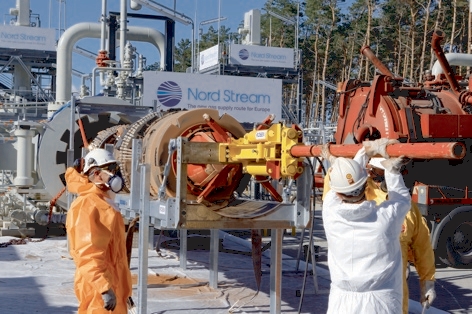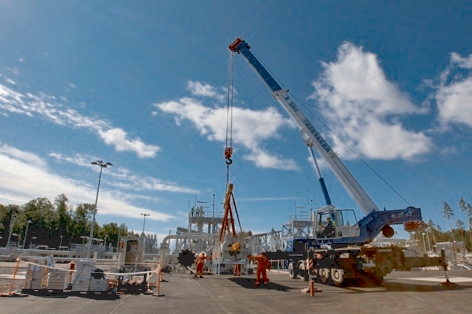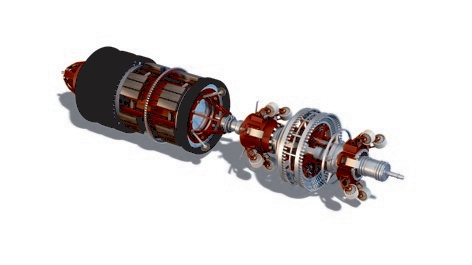The glamorous world of international espionage isn’t the first thing that springs to mind when someone mentions the inspection of oil and gas pipelines. But the tools used to measure the inside of pipes, known as pipeline inspection gauges or pigs, have long been synonymous with James Bond films.
In fact, pigs have featured in three Bond films to date. The British Secret Service officer can be seen disabling a pig in Diamonds are Forever in order to escape a pipeline; a pig was used to transport someone across the Iron Curtain in The Living Daylights; and another was used to carry a nuclear weapon through a pipeline in The World is Not Enough.
These tools were originally developed to remove deposits that could obstruct flow through a pipeline, but in 1961 Shell Development demonstrated that a self-contained electronic instrument could travel through a pipeline aboard a pig while measuring and recording wall thickness. And, as a result of further advances in technology, pigs are today more intelligent than ever.

Just last month, a so-called smart pig was used to measure the inside of a new 1,224km undersea pipe route between Russia and Germany. The €7.4bn (£6.3bn) Nord Stream route was built to take some of the stress off the antiquated Ukraine route, which was constructed in the 1970s and up until recently was responsible for transporting 80 percent of Russia’s gas exports to Europe.
Nord Stream consists of two offshore pipelines that provide the most direct connection between the vast natural gas reserves in Russia and the demanding energy markets in the European Union. Combined, the parallel pipelines, which are roughly 100 metres apart, have the capacity to transport a total of 55 billion cubic metres (bcm) of natural gas a year to businesses and households in the EU for at least 50 years, according to the Nord Stream AG company behind the project.
The magnetic field from strong magnets passing through the wall of the pipe is distorted if the wall thickness differs from the nominal one. These distortions of the magnetic field are detected and analysed.
Andrej Voronoc, Nord Stream
Each of the twin pipelines is made up of 100,000 24-tonne coated steel pipes and each bit of pipe is about 12 metres long with a 48 inch internal diameter. And given the importance of supplying so much fuel to so many people - and the costs involved - it’s vital to make sure everything is working as it should be.
‘As with any infrastructure, integrity management is essential to ensure that the pipeline can operate efficiently and safely throughout its planned operational life,’ said Nord Stream AG offshore operations manager Andrey Voronov.
‘The pipelines were designed and built for long-term operation – with thick steel walls, coated with concrete for stability on the sea bed, and with anti-corrosion coating. The comprehensive inspection and maintenance regime is a key part of our asset management strategy.’
On July 25, the 7m-long pig used to measure Nord Stream was inserted into a “pig trap” in Portovaya, Russia, where Russian energy giant and majority shareholder in the project, Gazprom, has a large presence due to the abundance of natural gas in the region. Over the next 10 days the pig was propelled down the pipe at 1.5m/s as a result of the gas pressure.

The PIG travelled all the way to Lubmin, Germany, where it was received by a similar pig trap, before being returned to Russia by road so that it could make its way down the second pipe a few weeks later.
Nord Stream’s pig – developed and manufactured last year by Rosen Group in Lingen, Germany – used a technique known as magnetic flux leakage (MFL) to inspect the pipeline. This involves emitting magnetic flux into the walls of the pipe to detect leaks, corrosion, or flaws. ‘The magnetic field from strong magnets passing through the wall of the pipe is distorted if the wall thickness differs from the nominal one,’ said Voronov. ‘These distortions of the magnetic field are detected by the tool and later analysed.’
But the magnet is just one of four measurement devices onboard the Rosen Group’s sophisticated pig. ‘The second device is a geometry-mapping calliper tool,’ said Voronov, explaining that the tool has ‘whiskers’ that bend if they pass over a dent in the pipe. ‘If the dent is large a few whiskers bend, and by measuring when, where and by how much the whiskers bend, we can get a complete picture of the pipeline geometry with accurate coordinates,” he said.
Even the smallest of leaks in gas pipelines of this magnitude can have disastrous consequences from both a financial and an environmental perspective
The pig also carries an inertial module onboard that includes an acceleration sensor for measuring the pig’s displacement in 3D as it moves through the pipeline. Finally, the pig measures any changes in the interior surface of the pipeline using a special type of electric current known as an eddy current. These are emitted by changing the magnetic field in an onboard conductor and help to detect shallow corrosion features that may exist in the pipeline.

While gliding through the 41mm thick pipes, the pig collected vast amounts of high-resolution data. In fact, it collected over a terabyte of data on the journey and recorded it at a rate equivalent to 12 Mb/s, roughly 30 times faster than cellular data networks. The data was then analysed by engineers and technicians to determine and report on the condition of the line.
‘The first evaluation of the results confirms that the pipelines have moved only minimally while being operated under full pressure and that there has been no corrosion or deformation,’ said Voronov.
The results of the internal and external inspections (carried out by remotely operated vehicles and support vessels) form the baseline data for regular inspection cycles in the coming years.
Even the smallest of leaks in gas pipelines of this magnitude can have disastrous consequences from both a financial and an environmental perspective. As a result, the measurements carried out by the pigs are crucial. ‘We plan on reusing the inspection tool again after about seven years to record a follow-up measurement for us to compare to the baseline,’ said Voronov.
Product news
Open design
Shimadzu has made its AGS-X Series table-top precision universal tester easier to use. The company said the tester’s open, multi-table design provides users extra work space, making operation easier, and can be used for arranging specimens or placing jigs. The product also has new one-touch stroke limiters that allow simple adjustment and firm locking of the crosshead stroke limit positions.
Surface area
Spectrum Metrology has introduced the Surtronic S100 series of portable surface-finish meters designed to fulfil a range of roughness measurement requirements. The Surtronic S100 can be used either freestanding (on horizontal, vertical or even inverted surfaces) or bench mounted, with fixturing for batch surface roughness measurement and laboratory applications. The 50mm stylus is designed to measure any surface without the need for expensive fixturing.
Wireless force
1st Machine Tool Accessories has introduced the Kitagawa KGFM series of wireless grip force meters, designed to measure the gripping force of chucks quickly and accurately. It can perform either a static test, or a dynamic test with the spindle running, in which case the instrument records the rev/min of the chuck as well as the force it applies to the billet or casting.
Digital probe
Solartron Metrology has introduced Orbit3, an accurate measuring system incorporating digital probes and an in-line connector designed to reduce repair, maintenance and replacement costs. Orbit3 comes as standard with SI100 and SI200 systems for connections into programmable logic controllers or automation technology. Options are available for where the connector is placed, eliminating the need to thread or unthread cabling.




Nanogenerator consumes CO2 to generate electricity
Whoopee, they've solved how to keep a light on but not a lot else.